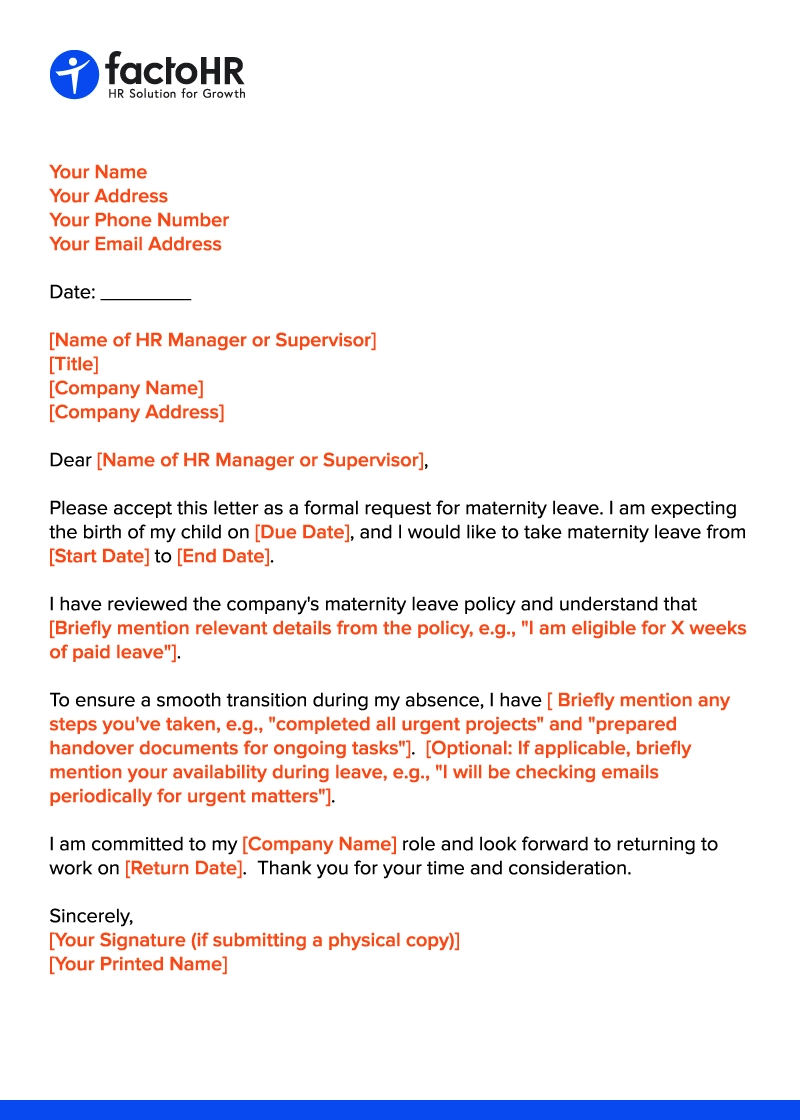How to Write a Maternity Leave Application

Table of Contents
A maternity leave application is a formal notification to your employer that you are taking time off for childbirth or the adoption process. This is not just to document the fact that you are taking the time off, but also helps the employer manage your responsibilities and deliverables.
Maternity leave application letter covers everything from expected leave periods, return dates, details of your handover plan, and communication boundaries. Ensuring a well-written maternity leave letter covers you from any legal hassles and helps your employer manage workload.
Now, the question is how to write a maternity leave application.
This guide focuses on offering a letter template and format that you can use to create such a document in no time. It also discusses tips and best practices to make your return to work letter after pregnancy effective.

What is a Maternity Leave Letter?
A maternity leave letter is an official written document, handed over by a pregnant woman to the employer. It informs employers of your desire to go on leave due to pregnancy and makes the request official and documented, allowing it to proceed through the HR processing procedure.
It typically includes the due date, recommended start and finish dates of leave, a timeline of returning to work, and possibly medical evidence, which the policy may require.
Simple Maternity Leave Letter Format to Your Employer
This basic maternity leave letter format is the best choice.

Download Free Maternity Leave Letter Format for Your Employer
Pregnancy Maternity Leave Letter Sample
Date: August 22, 2025.
Nikita Makwana
Sr. WordPress Developer
To,
Manoj Gosai
Team Manager
Zebra Pvt. Ltd.
Ahmedabad – 01
Dear Manoj Gosai,
This is my official application to be granted maternity leave beginning on September 1, 2025 until March 1, 2026. Relief of duties is to be made by Ankita Patel during this period.
Please revert if more documents are needed. Thanks.
Sincerely,
[Your Name]
Pro tips
- Before sending, be sure to review your company’s policy and any relevant legislation.
- To boost confidence, include a backup contact and handover document.
- Keep it professional and warm; only HR should have access to medical information.
How to Write a Maternity Leave Application?
A maternity leave letter should clearly state key facts initially, date, confirm a handover, and state preferences about contact in an official brief style. The following outline provides a workable HR-ready solution that is consistent with a professional maternity leave application format.
Here is a step-by-step guide you can follow,
Step 1: Employee Information
Begin with full name, designation, department, employee ID, and work location to be sure that HR is correctly mapped.
Step 2: Purpose
Clearly provide the purpose as an application to take pregnancy leave (maternity leave) with an expected due/placement date, where applicable.
Step 3: Leave Time
Entitle date, entitle termination date, number of weeks/days, estimated date of reemployment; indicate whether dates are subject to medical leave advice.
Step 4: Delegation/Handover
Assure who will take care of the duties, what to transfer, and where the records are stored (folders, trackers, project briefs).
Step 5: Preferred Contact
Specify how you would like to be contacted, how many hours you are available, and what may be considered an urgent escalation (or not).
Step 6: Thanks + Close
Thank the employer for his attention and support; include a polite closing, signature, and contact information.

Maternity Leave Application Samples and Email Templates
Here’s clear, friendly, copy-ready wording you can paste into an email or print as a letter with simple tips to make approval smooth and stress-free.
Sample 1: Maternity Leave Extension Letter
There are instances when you need to have more leave. The following is a sample maternity leave extension letter.
[Your Name]
[Designation]
[Date]
To,
[Manager’s Name]
[Company Name]
Extension of my maternity leave.
Dear [Manager’s Name],
I am at present on maternity leave, which expires on [original end date]. Because of [reason–medical recommendation/personal circumstances], I would seek an extension of the leave until [new end date]..
I promise that after this is over, I will report back to work. Thanks a lot.
Sincerely,
[Your Name]
Sample 2: Maternity Leave Application for Teachers
Teachers usually have to coordinate leave with the academic schedules. Here is a maternity leave application from teachers.
[Your Name]
[Designation – Teacher]
[School Name]
[Date]
To,
[Principal’s Name]
To: supervisor.
Dear [Principal’s Name],
This is the request for maternity leave between [start date] and [end date]. I will also hand it over with [substitute teacher] to ensure that the lesson syllabus proceeds.
I beg leave to request permission on this account.
Sincerely,
[Your Name]
Sample 3: Maternity Leave Email
For quick communication, you may prefer a maternity leave email.
[Your Name]
[Designation – Teacher]
[School Name]
[Date]
Dear [Manager’s Name],
This is an email to request maternity leave from [start date] to [end date]. I have also discussed with [colleague name] about task handovers to ensure continuity is smooth.
Thank you for your support.
Best regards,
[Your Name]
Sample 4: After Maternity Leave Joining Application
When resuming work, you must submit an after maternity leave joining application to notify HR formally.
[Your Name]
[Employee ID]
[Date]
To,
[Manager’s Name]
[Company Name]
Purpose: To join the workplace after the maternity period.
Dear [Manager’s Name],
I will resume on [date], at the expiry of my maternity leave. I will resume my duties.
Thank you for your support.
Sincerely,
[Your Name]
Sample 5: Return to Work Letter after Maternity Leave Template
This return-to-work letter after maternity leave template can help you transition smoothly.
[Your Name]
[Designation]
[Date]
To,
[HR/Manager’s Name]
Subject: Return to Work-Maternity Leave.
Dear [Manager’s Name],
I am hereby writing to tell you that I can resume work, effective [date]. Are there any formalities?
I also appreciate the way the company was accommodating me during my maternity leave.
Sincerely,
[Your Name]

How to Write an Acceptance of a Maternity Leave Application?
Employers are expected to send an acceptance letter of maternity leave to indicate that the leave has been approved. This will be mandatory and prevent conflict.
[Company Letterhead]
[Date]
To,
[Employee’s Name]
Dear [Employee’s Name],
Your leave request from [start date] to [end date] regarding maternity has been approved. Do also remember to hand over all handover activities before leaving.
Sincerely,
[Manager/HR Name]
Read More on:
Stressed about writing a leave approval letter? Get 5 FREE, manager-ready templates + a step-by-step guide on how to write it right in minutes
Final Thoughts
Maternity leave applications play a significant role in ensuring that there are well-documented records and that they comply with legal provisions. This guide will assist you not only with writing a maternity leave acceptance letter but also with making sure that all the necessary details, including date of leave, workload, and how the handover process will go, are documented.
Related reading for partners

FAQs
1. Is a Letter of Maternity Leave Binding?
Yes, a formal application will help the HR department properly record leave in writing and in compliance with the relevant regulations.
2. Can I Send an Email about Maternity Leave Instead of a Letter?
Yes, provided that it contains major details such as the time frame, commencement date, and delivery date.
3. When do I Give Notice of Maternity Leave?
Preferably, 6-8 weeks before you are due or according to company policy.
4. Is there a Variation in the Maternity Leave Application Form for Teachers?
And, yes, teachers have to make arrangements for lesson continuity and find someone to replace them.
5. What Happens if I have to Extend My Maternity Leave?
You may submit a letter of extension of maternity leave with medical evidence in case it is necessary.

Modernize your HR tasks with factoHR today
Experience the digitalization of everyday business activities with factoHR's modern and compatible solutions for every need.

© 2025 Copyright factoHR


